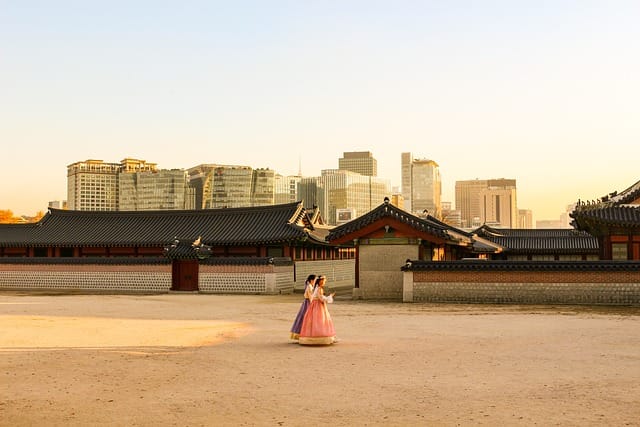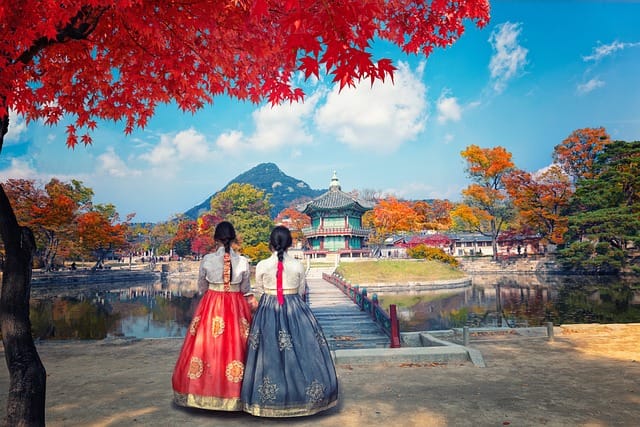Hanbok, the traditional Korean attire, boasts a long history and exquisite beauty. With diverse types and designs varying by era and social status, it is primarily worn on special occasions and events in modern times.
History of Hanbok
The history of Hanbok dates back to before the Three Kingdoms period and has evolved, reflecting the culture and characteristics of each nation, including Goguryeo, Baekje, and Silla. Particularly during the Joseon Dynasty, influenced by Confucianism, the culture of ceremonial dress flourished, leading to the emergence of various types of Hanbok with elaborate formalities.
Hanbok mainly consists of jeogori, pants, and skirt.

Components of Hanbok
- Jeogori: An upper garment worn by both men and women.
- Pants: Lower garments, available in men’s and women’s styles, with women’s pants worn as underpants.
- Skirt: A lower garment for women.
In addition, various outer garments such as vests, magoja, and durumagi can be worn together to enhance the style.
Types of Hanbok
Hanbok comes in various types depending on its purpose and social status.
- Ceremonial Dress: Clothing worn on special occasions like weddings and first birthday celebrations.
- Everyday Dress: Simplified clothing designed for comfortable daily wear.
- Official Uniform: Clothing worn by officials during the Joseon Dynasty.
Characteristics of Hanbok
Hanbok has the following characteristics:
- Harmony of Curves and Straight Lines: Natural curves and straight lines blend to create a beautiful silhouette.
- Diverse Colors: Vibrant and beautiful styles are achieved using various colors based on the five cardinal colors.
- Generous Fit: Designed with a loose fit for ease of movement.
- Flat Pattern Cutting: Fabric is used efficiently with a flat pattern cutting method, minimizing waste.
Modern Hanbok
In modern times, many Hanbok designs have emerged that enhance practicality by using contemporary designs and materials while preserving the beauty of traditional Hanbok. These Hanbok are comfortable for everyday wear and are beloved by the younger generation.
Hanbok Experience
In Korea, you can experience Hanbok at various locations. Stroll through palaces or traditional villages wearing Hanbok and experience Korean traditional culture.
- Hanbok Rental Shops: Many Hanbok rental shops are located in major tourist areas like Seoul and Busan.
- Palaces and Traditional Villages: Hanbok experience programs are available at Gyeongbokgung Palace, Changdeokgung Palace, Bukchon Hanok Village, and other sites.
- Hanbok Culture Experience Centers: Various Hanbok exhibitions and experience programs are offered.
Hanbok is a precious heritage representing Korea’s beautiful traditional culture. Experience the charm and beauty of Korea through Hanbok.
한복은 한국의 전통 의상으로, 오랜 역사와 아름다운 멋을 자랑합니다. 시대와 신분에 따라 다양한 종류와 디자인이 존재하며, 현대에는 특별한 날이나 행사에서 주로 착용됩니다.
한복의 역사
한복의 역사는 삼국시대 이전부터 시작되었으며, 고구려, 백제, 신라 등 각 나라의 문화와 특징을 반영하며 발전해왔습니다. 특히 조선시대에는 유교 사상의 영향으로 예복 문화가 발달하면서 다양한 종류와 격식을 갖춘 한복이 등장했습니다.
한복의 구성
한복은 크게 저고리, 바지, 치마로 구성됩니다.
- 저고리: 상의로, 남녀 모두 착용합니다.
- 바지: 하의로, 남성용과 여성용이 있으며, 여성용은 속바지 형태로 착용합니다.
- 치마: 하의로, 여성용입니다.
이 외에도 조끼, 마고자, 두루마기 등 다양한 덧옷을 함께 착용하여 멋을 더할 수 있습니다.
한복의 종류
한복은 용도와 신분에 따라 다양한 종류가 있습니다.
- 예복: 혼례복, 돌복 등 특별한 날에 입는 옷입니다.
- 평상복: 일상생활에서 편하게 입을 수 있도록 간소화된 옷입니다.
- 관복: 조선시대 관리들이 착용했던 옷입니다.
한복의 특징
한복은 다음과 같은 특징을 가지고 있습니다.
- 곡선과 직선의 조화: 자연스러운 곡선과 직선이 어우러져 아름다운 실루엣을 만들어냅니다.
- 다채로운 색감: 오방색을 기본으로 다양한 색상을 사용하여 화려하고 아름다운 멋을 냅니다.
- 넉넉한 품: 활동하기 편하도록 넉넉한 품으로 제작되었습니다.
- 평면 재단: 옷감을 낭비하지 않고 효율적으로 사용할 수 있도록 평면 재단 방식으로 제작됩니다.
현대 한복
현대에는 전통 한복의 아름다움을 유지하면서도 현대적인 디자인과 소재를 사용하여 실용성을 높인 한복들이 많이 등장하고 있습니다. 이러한 한복들은 일상생활에서도 편하게 착용할 수 있으며, 젊은 세대들에게도 많은 사랑을 받고 있습니다.
한복 체험
한국에서는 다양한 장소에서 한복 체험을 할 수 있습니다. 한복을 입고 고궁이나 전통마을을 거닐며 한국 전통 문화를 경험해 보세요.
- 한복 대여점: 서울, 부산 등 주요 관광지에 한복 대여점이 많습니다.
- 고궁 및 전통마을: 경복궁, 창덕궁, 북촌한옥마을 등에서 한복 체험 프로그램을 운영합니다.
- 한복 문화 체험관: 다양한 한복 전시와 체험 프로그램을 제공합니다.
한복은 한국의 아름다운 전통 문화를 대표하는 소중한 유산입니다. 한복을 통해 한국의 멋과 아름다움을 느껴보세요.
